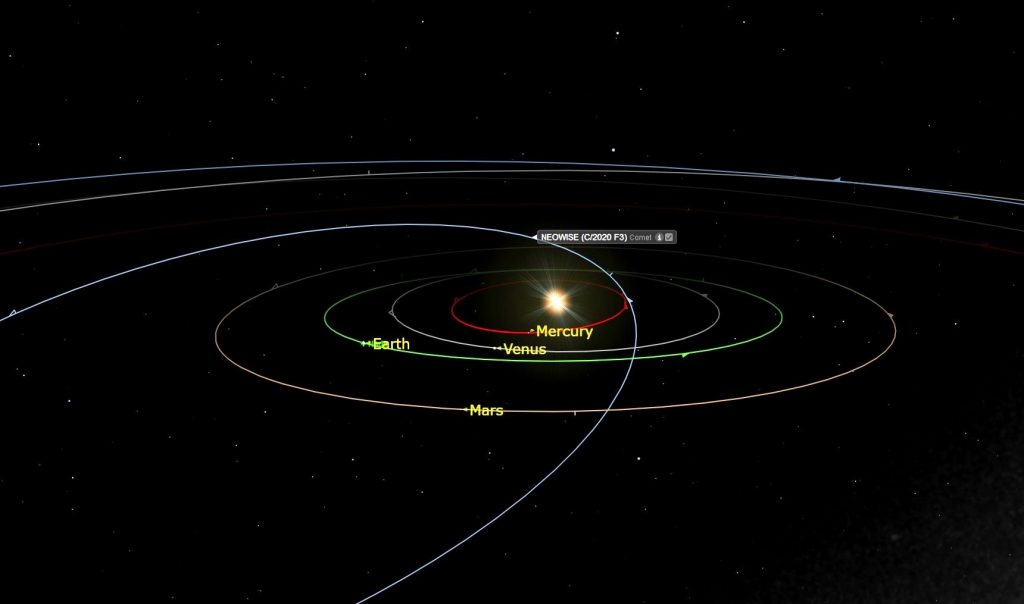The long-awaited bright comet C/2020 F3 NEOWISE will become visible after sunset this week.
All you will need to see it are clear skies to the northwest and a very low horizon that is free of obstructing trees and buildings. If you live in an apartment with western or north-facing windows or a balcony, you’re in luck, too.

You can see this comet with your unaided eyes, but it will become truly spectacular through binoculars and telescopes. What you should expect to see is a small, bright, fuzzy spot, possibly with an orange hue. Binoculars will reveal the comet’s faint tail extending generally upwards, away from the Sun. Actually, look for two tails pointed in slightly different directions — a brighter one composed of debris the comet is dropping behind it and a fainter, blue-tinted one composed of ionized gas. The latter tail will always point directly away from the Sun, since it’s being pushed by the solar wind. While your telescope will magnify the comet’s head nicely, its tail will extend beyond your limited field of view.
As comets swing through the Solar System, we see them move with respect to the background stars — night-to-night, and even hour-by-hour! This comet dropped into the outer Solar System from below (or south of) the plane of the planets’ orbits. It passed through that plane as it rounded the Sun just, beyond the orbit of Mercury, on July 3. Now it is swinging upwards (north of that plane) while it flies away from the Sun. That trajectory will bring the comet closest to the Earth at 9 p.m. EDT on Wednesday, July 22, when it will be 103.5 million kilometres or 0.692 Astronomical Units (1 AU is the mean Earth-Sun separation). Unfortunately, as the comet nears us, it will also be experiencing less heating from the Sun, causing it to fade in visual brightness due to less gas production. It’s a trade-off.

From our point of view on Earth, the comet is heading in a northwesterly direction. The northerly component of that motion will allow the comet to become circumpolar this week. That means it will never set, but it will remain close to the horizon during the night – making it easily visible only during the post-sunset and pre-dawn periods.
As the sky darkens July 12, the comet will become observable after about 9:45 p.m. in your local time zone. At that time, it will be less than a fist’s diameter (or 9 degrees) above the northwestern horizon, and descending. By 10:15 p.m., the comet will be only a palm’s width above the horizon. After 10:30 p.m., it will become too low to see clearly. Once the Sun has completely disappeared, you can safely sweep the sky for it with your binoculars.

The best news of all is that the comet will climb nearly a thumb’s width (or 2 degrees) higher every night, making viewing much easier. By the evening of July 19, the comet will be shining in a darker sky. Its position will be about 1.5 fist diameters below the stars Dubhe and Merak in the Big Dipper.
For those who want to see the comet before sunrise, it will rise Monday, July 13 at about 2 a.m. local time. (Rise time varies by your latitude). It will be located about two fist diameters to the lower left (or 20 degrees to the celestial east of) the very bright star Capella, over the northwestern horizon. On the coming weekend, the comet will drop lower — moving to the lower right of Merak.

My friend Blake Nancarrow and I recorded a half-hour video about finding, viewing and photographing the comet. It’s on the RASC Toronto Centre’s YouTube channel here. Let me know if you see it, or get a photo of it!
Chris Vaughan is a science writer, geophysicist, astronomer, planetary scientist and an “outreach RASCal.” He writes Astronomy Skylights, and you can follow him on Twitter at @astrogeoguy. He can also bring his Digital Starlab portable inflatable planetarium to your school or other daytime or evening event. Contact him through AstroGeo.ca to tour the universe together.





